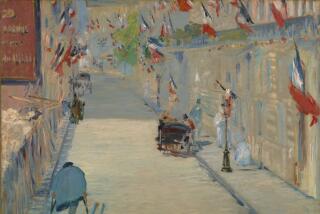A ride back in time to Monet’s pastoral world
- Share via
There were good omens one recent spring morning: sunshine after rain, cafe creme and Annick Goutal’s Eau du Ciel soap. I decided to capitalize on these signs by visiting painter Claude Monet’s home and garden in the village of Giverny, a 45-minute train ride from Paris.
Together with Chartres and Versailles, it’s the classic day trip, taking you into the sweet French countryside with no cares or luggage, then back to the city. My mother did it about 20 years ago, so it had long been in the back of my mind to go.
Monet lived in a rambling pink house at Giverny from 1883 until his death in 1926, with his cheaper-by-the-dozen family: two sons from his first marriage, his indomitable second wife, Alice, her six children and, later, several of her grandchildren. Grainy photos of him show an old man with a long, white beard, a sort of French Impressionist Moses.
At Giverny, Monet finally reaped the rewards of artistic recognition, collected the 18th and 19th century Japanese woodblock prints that inspired him, gave directions to a small squad of gardeners and painted, of course. “Besides painting and gardening, I don’t know how to do anything,” he once said.
For a time, failing eyesight hampered his work, but in 1923 he submitted to cataract surgery, giving him back the world in living color.
On my trip to Giverny, I took with me a copy of “Linnea in Monet’s Garden,” a children’s book by Christina Bjork and Lena Anderson. A column reader had told me it was the best guide to Giverny.
I opened the book while waiting for my train in a cafe at the Gare St. Lazare, one of those wondrous open-air, wrought-iron-and-glass Belle Epoque railway stations, where pigeons fly past as you wait for your track to be posted. In 1877, Monet painted it all steamed up with train smoke and the feeling of travel.
I found “Linnea in Monet’s Garden” as good a guide to Giverny as a person could want. It tells the story of a Swedish girl who loves flowers, and visits France to seek out everything related to Monet, especially his water lily paintings. It’s meant to introduce children to Impressionist art, and it describes, in a simple way, Monet’s complicated life and aesthetic philosophy.
The quarries and parking lots of the Paris suburbs yielded to open fields where French painters a generation before Monet -- such as Jean-Baptiste-Camille Corot and Jean-Francois Millet -- discovered the benefits of painting outdoors. The Impressionists took the idea a step further by noting that a landscape looks different at different times of the day, which is partly why Monet painted the same haystacks, cathedrals and water lilies time after time, tracking the way light transformed them.
At the Vernon station, I could have caught the bus or taken a taxi to Monet’s house. Instead, I rented a bicycle at a cafe across the street, then rode through town and over the river, effortlessly finding the bike path on the other side that led me straight to Giverny in less than 30 minutes.
Along the way, I got an occasional whiff of deep purple lilacs, a flower right out of my favorite Monet, “Rest Under the Lilacs,” painted around 1875 and now at the Musee d’Orsay in Paris.
Though there were more tourists than I expected on a weekday early in the season, the hamlet had a peaceful air, with a few restaurants, art galleries and a small museum devoted to American art.
In the cemetery by the church it was easy to find the plot of the extended Monet family, each member bien aimes (or “well loved”), according to the grave markers. On the far side of town, at the entrance to Monet’s house, I parked my bike and went in.
First, I passed through the big room that was the artist’s studio, now a gift shop, and took a quick tour of the house, with its Hiroshige prints, old family photos and yellow dining room table seating 16. Then I strolled through the orchard that Monet converted into a flower garden, all geometric beds planted in harmonized color groupings: orange and yellow azaleas, pansies and slightly flagging tulips; blue and purple foxglove, hibiscus and flax. At the time, children in field-trip packs also appeared to be growing in Monet’s garden, their heads barely cresting the flower tops.
Monet’s famous lily pond is on the far side of a two-lane highway, with a tunnel underneath for safe crossing. A network of paths, bordered by weeping willows, circles the pond in a seemingly aimless fashion.
Suddenly, though, you round a curve and find exactly what you came for: the green Japanese bridge, canopied in wisteria, so often painted by the artist, and the lily pads that consumed his attention in the twilight of his life.
Later, I thought, the shrieking Expressionists and cold abstract painters would change the way we see the world again. But at Giverny, time is frozen, the beautiful version of reality holds sway, suggesting an unending chain of days as fine as this one, if we only know how to seize them.
Susan Spano’s “Postcards From Paris” are posted at www.latimes.com/susanspano. She welcomes comments at [email protected] but regrets that she cannot respond to them individually.
More to Read
Sign up for The Wild
We’ll help you find the best places to hike, bike and run, as well as the perfect silent spots for meditation and yoga.
You may occasionally receive promotional content from the Los Angeles Times.






